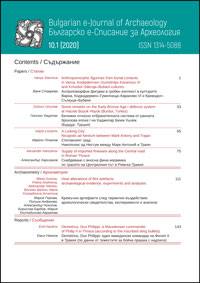Supply of imported fineware along the Central road in Roman Thrace
Supply of imported fineware along the Central road in Roman Thrace
Author(s): Alexander HarizanovSubject(s): History, Archaeology
Published by: Асоциация на българските археолози
Keywords: Roman Thrace; Via Diagonalis; imported fineware; goods supply;
Summary/Abstract: This contribution explores the archaeological evidence for the supply of imported fineware along the Central road (Via Diagonalis) in the province of Thrace during the Principate. Finds from twelve sites situated in close proximity to its route have been examined.According to the available data, the import of ceramic goods started around the time of the road’s construction during the reign of Emperor Nero, at the latest. Italian and South Gaulish sigillata along with thin-walled pottery were among the earliest documented imports in Serdica, together with products of Western Asia Minor and/or the Pontic region. Later on, products of Pergamene (Eastern sigillata C), Pontic and probably also Moesian workshops were attested.Philippopolis, and sites studied from its territory, were supplied with fine wares, originating from Western Asia Minor (ESC, Eastern sigillata B) and the Pontic region (Pontic sigillata) since the second-third quarter of the 1st century AD. During the 2nd and the first half of the 3rd century the majority of ceramic goods came from the Pergamon region, supplemented with occasional imports of ESB, Cnidian relief wares, etc.The sites from the territories of Augusta Traiana and Hadrianopolis, as well as Hadrianopolis itself, were supplied during the 2nd and 3rd century with fine wares mainly from the region of Pergamon. A small number of finds of Eastern sigillata A and B, Pontic sigillata and African red slip ware shows alternative extra-provincial sources of goods.The evidence from the transport containers indicate that the bulk of amphora-borne commodities came from similar to the abovementioned provenances, so it could be suggested that at least some of the imported ceramic artefacts could have been transported as side products of wine, olive oil and other agricultural stocks.
Journal: Българско е-Списание за Археология
- Issue Year: 10/2020
- Issue No: 1
- Page Range: 75-110
- Page Count: 36
- Language: English

